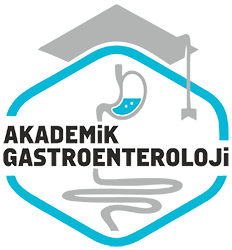Agustos 2018
Gastrointestinal sistem kanamali hastalarda sok indeksi ve hematokrit düzeylerinin mortalite üzerine etkisi
The effect of shock index and hematocrit levels on mortality in patients with gastrointestinal bleeding
- Ana Sayfa
- Sayılar
- Agustos 2018
- Gastrointestinal sistem kanamali hastalarda sok indeksi ve hematokrit düzeylerinin mortalite üzerine etkisi...
Erciyes Üniversitesi Tip Fakültesi, 2Acil Tip Anabilim Dali, 3Iç Hastaliklari Anabilim Dali, 6Biyoistatistik Anabilim Dali, Kayseri
Nevsehir Devlet Hastanesi, 4Acil Servisi, Nevsehir
Ünye Devlet Hastanesi, 5Acil Servisi, Ünye, Ordu
Özet
Giriş ve Amaç: Sok indeksi ve hematokrit düzeyinin gastrointestinalsistem kanamali hastalarda mortalite üzerine etkisinin arastirilmasi. Gereç ve Yöntem: çalışma 01.01.2013-30.09.2015 tarihleri arasındaacil servise gastrointestinal sistem kanama semptomları ile basvuran,endoskopik yöntemler ile tanısı konulan Hastaların dosyalari ve laboratuvar sonuçları geriye dönük değerlendirilerek yapilmıştır. Dosya değerlendirilmesi sonucu acil servise başvuru anindaki vital bulgulari, ilk alinankan tahlillerinin sonuçları, yapılan endoskopik islemlerin sonuçları vehastanın yatış ve taburculugu değerlendirilmeye alinmıştır. çalışma için709 hasta belirlenip 266 hasta uygun bulunmustur ve dosya taramasısonucu, dosyalarina eksiksiz ulasilan 150 hasta çalışmaya dâhil edilmiş-tir. Bulgular: çalışmada 150 hastanın 94’ü erkek olarak bulunmustur.65 yaş ve üstü olanlarin toplam hasta sayisinin yarisina tekabül ettigigörülmüstür. En sık sikâyet kanli kusma ve siyah diskilama bulunmustur.Hastaların mortalite oranina bakildiginda %25 olarak hesaplanmıştır.Hastaların başvuru vitalleri değerlendirilmesi sonucu sok indeksinin mortalite üzerine etkisinin olmadigi bulunmustur (p >0,05). Ilk alinan kannumuneleri sonucuna göre hematokrit değerlerlerinin mortalitenin öngörülmesinde yetersiz olduğu saptanmıştır (p >0,05).Sonuç: Sok indeksi ve hematokrit düzeyini mortaliteyi ön görmede yetersiz kaldigi, baskaverilerle desteklenmesi gerektigi sonucuna ulasilmıştır.
Abstract
Background and Aims: The aim of this study was to investigate theinfluence of shock index, and hematocrit levels on the course of diseaseand mortality in patients with gastrointestinal bleeding. Material andMethods: This study was conducted as a retrospective analysis of laboratory results and medical records of patients referred to the emergency room from January 1, 2013, to September 30, 2015, who presentedwith gastrointestinal bleeding symptoms and diagnosed by endoscopicmethods. Vital signs on emergency room referral, results of endoscopicinterventions and initial blood tests, and the number of hospitalizationsand discharges were noted after chart reviews. A total of 709 patientswere identified, of whom 266 were found to be eligible. A total of 150patients whose medical records were accessible were included in thisstudy after the chart surveys. Results: Of the study patients, 94 weremales, and patients aged >65 years constituted half of the study population. The most frequent complaints were hematemesis and blackstool. The mortality rate among the patients was calculated as 25%.After evaluating the patients’ initial vital signs, we found that therewas no effect of shock index on mortality (p > 0.05). The initial bloodsample results showed that the hematocrit levels were inadequate inpredicting mortality (p > 0.05). Conclusion: Predicting mortality usingonly the shock index and hematocrit levels was found to be inadequate;therefore, these parameters should be supported by additional data.



